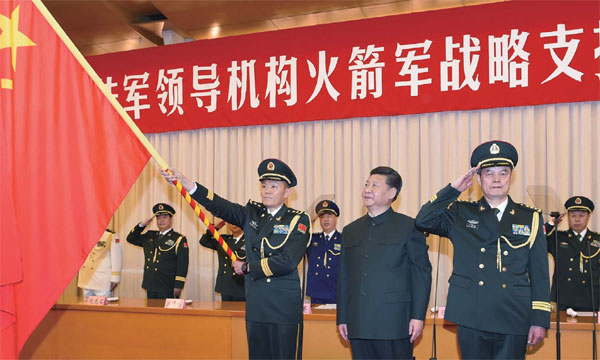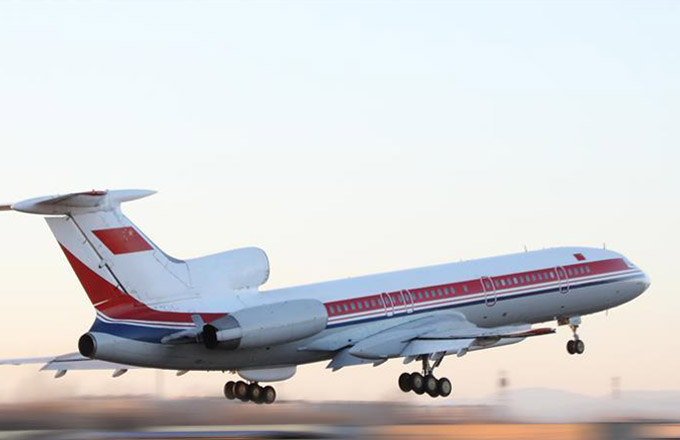PLA restructured in major reform
New command center, and rocket and strategic support forces form part of People's Liberation Army modernization
The People's Liberation Army has made a historic restructuring of its branches under an unprecedented military reform ordered by President Xi Jinping unfolds.
During a ceremony at the Central Military Commission office building in Beijing on Dec 31, Xi, who is also chairman of the commission, announced the establishment of the PLA Army Headquarters, the PLA Rocket Force and the PLA Strategic Support Force.
|
President Xi Jinping passes the flag of the People's Liberation Army to Gao Jin (left), commander of the PLA Strategic Support Force, at an inauguration ceremony for three new military units in Beijing on Dec 31. Li Gang / Xinhua |
The moves are a milestone in the modernization of the Chinese military, Xi said.
The president asked the PLA to improve its information and joint operation capabilities. He urged the rocket force to enhance nuclear deterrence and counterstrike capacity and to strengthen medium- and long-range precision strike capabilities.
Speaking of the strategic support force, Xi said the new branch is a "new type of combat force", and he asked it to improve the integration of the PLA's support systems and the links between civilian and defense sectors.
Based on reports by the PLA Daily, the strategic support force will take charge of a wide range of support functions, such as intelligence, technical reconnaissance, electronic warfare and logistics.
Previously, the PLA's ground force did not have a headquarters, as its units were under the direct control of the Central Military Commission. The seven regional military commands were in charge of the detailed operations of ground units stationed within their jurisdictions.
The rearrangement of the PLA is the latest step Xi has taken to carry out the overhaul of the Chinese military, which started in September when the president announced that China would cut the number of troops by 300,000.
In late November, a plenary session of the Central Military Commission presided over by Xi released a plan to reorganize the commission itself and the current seven military regions.
In addition, the proportion of each service in the military would be adjusted to optimize the operational capabilities of each, the plan stipulates.
At recent news conferences, Defense Ministry spokesman Yang Yujun explained that after the reform the Central Military Commission would become slimmer and more efficient, while decisions on some specific matters will be left to lower-level authorities.
He stressed that the establishment of the rocket force doesn't mean China is changing its nuclear policy or strategy.
Reiterating the no-first-use nuclear weapons policy and the country's defensive nuclear strategy, the spokesman said China always keeps its nuclear capability at the minimum level required for safeguarding its national security.
The rocket force's predecessor, the PLA Second Artillery Corps, was formed in 1966 to operate the country's strategic missiles. Its name was given by then-premier Zhou Enlai in an attempt to keep its true functions secret. The missile force made its public debut in 1984.
Lou Yaoliang, head of military strategy studies at the National Defense University, says that, although the PLA has been reforming for years, this latest round guided by Xi will be "the biggest one in terms of strength, scope, the difficulties it will meet, and its impact".
The establishment of leading organs for the PLA Army is a highlight, he says. In the past, more than 20 PLA central departments were in charge of various aspects of the ground force, leading to a host of obstacles in the effort to build a strong army, Lou says.
"The establishment of the army headquarters also means the PLA has begun to change its long-held army-centered mentality," he says.
Yao Yunzhu, a senior researcher at the PLA Academy of Military Science, says the establishment of the strategic support force will integrate the support forces of different services to improve efficiency and save costs.
Meanwhile, some weapons experts have suggested that the PLA will need to set up inter-services platforms and more universal hardware to improve its combat readiness.
Wang Ya'nan, deputy editor-in-chief of Aerospace Knowledge magazine, says: "President Xi has repeatedly stressed the importance of information and joint operation capabilities, which I believe are pillars to winning modern warfare.
"So the PLA should give priority to developing an inter-services command and logistics system."
He says the PLA Army, Navy, Air Force and Rocket Force, currently have their own platforms to handle information, maneuver units and arrange logistics.
Wang says these separate platforms should be integrated to allow a smoother chain of command. He also suggests that a universal early-warning and control system and long-range transport aircraft are needed for all services, rather than just the air force.
"Information obtained by an inter-services early-warning and control system can be simultaneously shared by different forces, ensuring the timely and accurate awareness of battlefield information and facilitating joint operations," he says.
Wang adds that large planes like the Y-20, which made its maiden flight in January 2013, and which developers expect to deliver to the PLA soon, will make troop deployment easier, enabling the military to act more promptly and to better respond to emergencies.
He says the army, the PLA's largest branch, should develop a next-generation main battle tank, which he proposes should be highly automated and have better information capability than the current Type-99A tank.
Cao Weidong, a researcher at the PLA Naval Military Studies Research Institute, says for the army, air force, navy and missile forces to act in concert with each other, more military satellites will be needed as they will play an increasingly important role in obtaining information and transmitting directives among different fighting units.
"The air force and navy will need more equipment that can perform or support long-range operations. For instance, the navy will need amphibious assault ships, large supply vessels and advanced guided missile destroyers, while the air force will pursue long-range refueling aircraft," he says.
Wu Peixin, a military observer in Beijing, says the PLA should develop new individual smart weapons and portable logistics devices, which will strengthen each soldier's combat capability.
zhaolei@chinadaily.com.cn



















